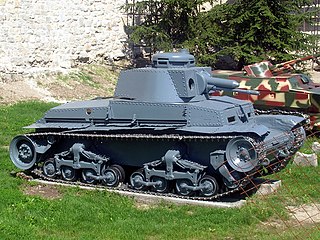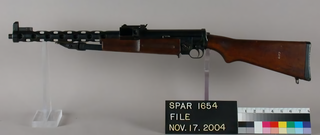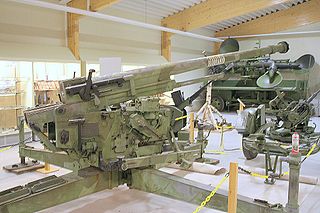
The Panzerkampfwagen 35(t), commonly shortened to Panzer 35(t) or abbreviated as Pz.Kpfw. 35(t), was a Czechoslovak-designed light tank used mainly by Nazi Germany during World War II. The letter (t) stood for tschechisch (German for "Czech"). In Czechoslovak service, it had the formal designation Lehký tank vzor 35 (Light Tank Model 35), but was commonly referred to as the LT vz. 35 or LT-35.

The ZK-383 is a submachine gun developed by the Koucký brothers, who worked at the pre-war Československá zbrojovka, akc.spol. arms factory in Brno, Czechoslovakia. It was produced at a slow rate from 1938 onwards and was exported as far away as Bolivia and Venezuela.

The 3,7 cm KPÚV vz. 34 was an anti-tank gun produced by the Škoda Works in Czechoslovakia. Škoda's own designation for it was A3. It is not known if guns seized by Germany after the occupation of Bohemia-Moravia saw service in World War II. Slovakia acquired 113 when it declared independence from Czechoslovakia in March 1939.

The Pistole vz. 82 is a compact semi-automatic pistol made for the Czechoslovakian military. "vz." is an abbreviation for "vzor", which translates to "model." A civilian export version is called the CZ 83.

The 3,7 cm KPÚV vz. 37 was an anti-tank gun produced by the Škoda Works that saw service in World War II. Originally designed for the Czechoslovak Army, some were also sold to Yugoslavia. A number were appropriated by the Germans after the German occupation of Czechoslovakia in 1939 and used under the designations 3,7 cm PaK 37 (t). Captured Yugoslav guns were used under the designation of 3,7 cm Pak 156 (j). Slovakia acquired 158 when it declared independence from Czechoslovakia in March 1939.

The vz. 27 is a Czechoslovak semi-automatic pistol, based on the pistole vz. 24, and chambered for 7.65 mm Browning/.32 ACP. It is often designated the CZ 27 after the naming scheme used by the Česká zbrojovka factory for post-World War II commercial products. However, it is correctly known as vz. 27, an abbreviation of the Czech "vzor 27", or "Model 27".

The OA vz. 27 was a Czechoslovak-designed armored car used by Nazi Germany, Slovakia, and Romania during World War II. Fifteen were built, of which the Germans seized nine when they occupied Bohemia-Moravia in March 1939 and the Slovaks captured three when they declared independence from Czechoslovakia at the same time. Romania acquired three when Czech troops sought refuge in Romania after the Hungarian invasion of Carpatho-Ukraine that same month. All were used for training or internal security duties during the war.

The 10 cm houfnice vz. 30 was a Czechoslovak howitzer used in the Second World War. The 158 weapons captured after the German invasion of Czechoslovakia in March 1939 were taken into Wehrmacht service as the 10 cm leFH 30(t). It was used by a variety of German units during World War II, including II. and III./SS-Artillerie-Abteilung 3 between 1939 and 1940 and SS-Artillerie-Abteilung 51 during 1941. 30 served with the Slovak Army.
The 15 cm hrubá houfnice vz. 25 was a Czech heavy howitzer used in the Second World War. It was taken into Wehrmacht service as the 15 cm sFH 25(t). Slovakia had 126 in inventory.

The 10.5 cm hrubý kanón vz. 35 was a Czech field gun used in the Second World War. Those weapons captured after the German occupation of Czechoslovakia in March 1939 were taken into Wehrmacht service as the 10.5 cm K 35(t). Former Yugoslav guns were designated as the 10.5 cm Kanone 339(j). It was used by a variety of German units during World War II, especially on coastal defense duties. 36 were in service with the Slovak Army.

The LT vz. 34, formally designated as Lehký tank vzor 34 was a Czechoslovak-designed light tank used mainly by Slovakia during World War II. Its suspension was based on that of the Carden-Loyd tankette, of which the Czechs had purchased three, plus a manufacturing license, in 1930. Dissatisfied with the prototypes of the Tančík vz. 33 tankette, the Czech Army decided that it would be easier to design a light tank from scratch rather than modify a tankette's chassis to carry a fully rotating armored turret. 50 were built, the last of which was delivered during 1936, of which the Germans captured 22 - including the prototype, when they occupied Bohemia-Moravia in March 1939, but they promptly scrapped them. The Slovaks seized the remaining 27 when they declared independence from Czechoslovakia at the same time. In Slovak service it only saw combat during the Slovak National Uprising.

The Tančík vz. 33 was a Czechoslovak-designed tankette used mainly by Slovakia during World War II. Seventy-four were built. The Germans seized forty when they occupied Bohemia-Moravia in March 1939; there is no record of their use. The Slovak Republic inherited thirty at the same time when it declared independence from Czechoslovakia. In Slovak service it only saw combat during the Slovak National Uprising.

The OA vz. 30 was a Czechoslovak-designed armored car used by Czechoslovakia in the 1930s and by Nazi Germany, Slovakia, Romania and Hungary during World War II. Fifty-one were built, of which the Germans seized twenty-four when they occupied Bohemia-Moravia in March 1939 and the Slovaks captured eighteen when they declared independence from Czechoslovakia at the same time. Romania acquired nine when Czech troops sought refuge in Romania after the Hungarian invasion of Carpatho-Ukraine that same month. Slovak vehicles saw combat in the Slovak-Hungarian War, the invasion of Poland, the opening months of Operation Barbarossa and the Slovak National Uprising.

The 7.5 cm kanon PL vz. 37 was a Czech anti-aircraft gun used in World War II. Those weapons captured after the German occupation of Czechoslovakia in March 1939 were taken into Wehrmacht service as the 7.5 cm Flak M 37(t) or Flak Skoda. The Germans sold many of them to Italy where they were designated as the Cannone da 75/49 or 75/50. Surviving guns were taken back into German service after Italy's surrender in 1943. Twenty were sold to the Finns in November 1940. Twelve were in Luftwaffe service between April and September 1944.

The 8.35 cm PL kanon vz. 22 was a Czech anti-aircraft gun used during World War II. Those weapons captured after the German occupation of Czechoslovakia in March 1939 were taken into Wehrmacht service as the 8.35 cm Flak 22(t). Some guns were reportedly captured in Yugoslavia as well. 144 were in Czech service during the Munich Crisis in September 1938 of which Slovakia seized between twenty-five and twenty-nine when it declared independence six months later. One hundred seven were in German service in August 1943, declining to twenty by October 1944.
The 8 cm minomet vz. 36 was a medium mortar designed by the Škoda Works during the Thirties. Intended as standard medium infantry mortar for the Czechoslovak Army all available weapons were impressed into service by the German Army when they occupied Bohemia-Moravia in March 1939 and the Slovaks seized approximately one hundred fifty when they declared independence from Czechoslovakia at the same time. Slovak weapons saw combat in the Slovak-Hungarian War, the invasion of Poland, the opening months of Operation Barbarossa and the Slovak National Uprising.
The pistole vz. 22 was the first Czech Army pistol of the inter-war period. The vz. 22 was based upon the work of Mauser designer Josef Nickl's Model 1915 handgun. Slovakia seized over seven thousand vz. 22s when it declared its independence from Czechoslovakia in March 1939.

This article deals with the history of tanks employed by military forces in Czechoslovakia from the interwar period, and the more conventional tanks designed for the Czechoslovak Army before World War II, and the tanks that ended up as Panzers of the German Wehrmacht during World War II, or in the use of other countries who purchased them before the war began.

The ZB-60 was a heavy machine gun designed by Zbrojovka Brno in Czechoslovakia during the 1930s. Weapons acquired after the German occupation of Czechoslovakia in March 1939 were taken into Wehrmacht service as the 15 mm FlaMG 39(t); Former Yugoslav guns were designated as the 15 mm FlaMG 490(j). The Germans used them as light anti-aircraft guns during World War II. The British developed their 15 mm Besa Mk I from the ZB-60 for service on armored fighting vehicles.
















